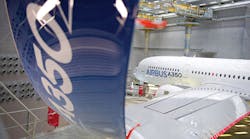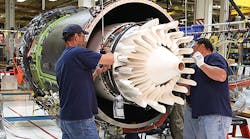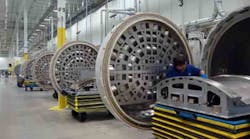The What, Why, and How for Aerospace Composites, and What Comes Next
Hold tight to that helium balloon, or you know what’ll happen: It’ll go up, up, up and away because it’s lighter than the air it displaces. However, an object doesn’t have to be that light to get airborne and stay there. For instance, air pressure variations lift a plane off the ground thanks to the shape of the wings.
That doesn’t mean lighter planes are a bad idea, though. They use less fuel, and, therefore, create fewer harmful emissions. The development of lighter materials, or composites, in the aerospace industry has been underway for decades – and it’s ongoing. Composite materials were a breakthrough, and they’re still being improved.
What are composites? — Usually, composites are formed as combinations of carbon fibers and resin, a type of plastic. Known as carbon fiber reinforced plastics, or CFRPs, these materials are roughly five times stronger and 60% less dense than standard aerospace aluminum. CFRPs also are highly resistant to heat.
During the 1960s, manufacturers of military aircraft began using composite materials. In the following decade, passenger airlines jumped on the bandwagon. As of the early 21st century, airframes — wings, fuselages, tail assemblies and landing gear — of civilian airliners are about 50% CFRPs. Composites also are used to form engine housings, fan casings, floorboards and interior components.
Some early forms of composites had honeycomb-like structures devised to make them even lighter. However, open spaces reduced overall strength, so manufacturers turned to solid CFRPs.
The use of CFRPs is not limited to civilian aircraft, either. Gliders, hot air balloons, gondola lifts, and fighter planes and spacecraft all have composite components as well.
How are composites made? — During the manufacturing of most civilian airframes, parallel carbon fibers bind with epoxy resin to create thin sheets or plies. Plies are arranged in layers with carbon fibers at different angles. Manufacturers control the strength and flexibility of CFRPs through the relative positions of fiber layers.
Originally technicians had to arrange carbon fibers by hand, which prolonged production and increased costs. Eventually, machines took over the tedious work and operations have been sped up considerably.
Once sufficient plies have been put in place, the materials are cured in an autoclave — a pressure-controlled chamber in which temperature and pressure are used to establish the intended structural and tensile characteristics of the finished material. The application of heat permanently bonds fibers and resin, after which the treated substance is referred to as “thermoset CFRP.”
Combining fibers and resin so that no holes form is critical to making strong CFRPs. Some manufacturers, therefore, use carbons that are pre-treated with resin. These fibers will maintain their integrity for only about two weeks at room temperature, however, so they need to be held in refrigerated storage units. Also, the autoclave step is a slow and expensive procedure.
In response, some composite makers have started to inject resin under high pressure directly into carbon fiber layers to create “thermoplastics.” These don’t require the subsequent curing cycle because materials “heat bond” during manufacturing.
Why choose composites? — Composites have certain advantages over metal construction. Because components are molded into single pieces that don’t require assembly, they’re both stronger and lighter than most metal alternatives.
Additionally, CFRPs are very sturdy because of the fiber-resin combination. This diminishes the possibility of substantial cracks forming, as small fissures will not expand because of the surrounding fibers.
Corrosion also is an issue with aluminum construction, but composites don’t corrode. Because of this quality, airline cabins can maintain higher humidity levels, which is important to maintaining passengers’ comfort.
Aluminum is also susceptible to metal fatigue, but progressive damage is less of a threat with CFRPs. Therefore, cabin pressures can be higher, which is another factor that contributes to a more enjoyable flight.
What are some problems? — Though the use of CFRPs presents some challenges, continuing research is working to address many of the issues. Perhaps the foremost challenge is the cost. Even with the development of new production machinery, the manufacturing of composites continues to be expensive and labor-intensive.
Composites cannot fully replace metal yet, either. Some types of impact cause CFRP erosion, while metal is less affected.
Maintenance is an important concern. Serious repairs interrupt airlines’ schedules. For instance, more technicians are available to repair metal aircraft structures than composite components. Furthermore, even if an expert is available, some CFRPs must be kept cold until needed.
If a repair is local, the composite material requires thawing before heading to the airplane. If CFRPs must be transported long distance — and sent through customs inspection — repair is postponed even more. A long border delay can cause the composites to spoil and become unusable.
Another major concern facing composites is that they hold up well — until they don’t. Aluminum structures usually bend before breaking and thereby provide a warning of potential failure. However, CFRP components often give no indications of stress until they are already dangerously overloaded.
What’s in store? — Advancements in aerospace composite materials are continuing. Some compelling, current research is looking at using nanoparticles to enhance strength — where charged particles bind to neighbors with opposite charges.
Researchers also are studying how to improve composites’ damage detection and repair methods, with the goal of making these necessary steps more automatic.
New types of composites are under development as well. It’s possible that silicon-based materials might be able to withstand even greater pressure than CFRPs. Much stronger and lighter metal composites could replace aluminum components, too.
With promising improvements now foreseeable, it’s possible that future aircraft may consist entirely of composite materials.Megan Ray Nichols enjoys writing about a variety of aerospace topics. She is an amateur astronomer and environmentalist. Megan enjoys reading and writing in a variety of scientific fields. Follow her on twitter @nicholsrmegan.











